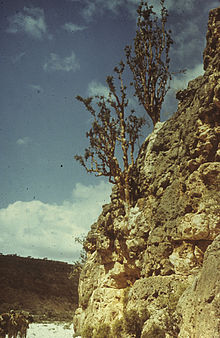| Boswellia frereana | |
|---|---|

| |
| Scientific classification | |
| Kingdom: | Plantae |
| Clade: | Tracheophytes |
| Clade: | Angiosperms |
| Clade: | Eudicots |
| Clade: | Rosids |
| Order: | Sapindales |
| Family: | Burseraceae |
| Genus: | Boswellia |
| Species: | B. frereana |
| Binomial name | |
| Boswellia frereana Birdw. | |
Boswellia frereana is a species of plant native to northern Somalia where it is known as yagcar, yagar, yigaar, or yegaar. Its frankincense is nicknamed the king of all frankincense, and called by the locals maydi (other spellings include: meydi, meyti, maidi, maieti, and mayeti) or the common name for all frankincense, fooh..The specific epithet refers to William Edward Frere, Member of Council at Bombay.
Other than its aromatic uses, the locals also use it for medicinal purposes; they make it into a paste called "malmal" and apply it on the joints to treat inflammation and arthritis. It is reported to be cultivated in Yemen, but this is more than likely based on an 1870 record by Dr. G. Birdwood citing that B. frereana was seen in Sir Robert Playfair's garden in Aden (Yemen). Playfair had brought B. frereana from Somalia and cultivated it in his garden in Aden. Although rumored to also grow in Oman, scientific and botanical evidence does not confirm that B. frereana either grows or is cultivated there.
In the West B. frereana is called "Coptic Frankincense" as this is the type and grade used by the Coptic Church of Egypt. 80% of B. frereana production is sold to Saudi Arabia where it is traditionally brought home by Muslim pilgrims. The remaining 20% is sold all around the world.
References
- ^ Hepper, F. Nigel (1969). "Arabian and African Frankincense Trees". Journal of Egyptian Archaeology. 55: 66–72. doi:10.2307/3856001. JSTOR 3856001.
- ^ Thulin, M.; Warfa, A. M. (1987). "The frankincense trees (Boswellia spp., Burceraceae) of northern Somalia and southern Arabia". Kew Bulletin. 42 (3): 487–500. doi:10.2307/4110063. JSTOR 4110063.
- ^ Tucker, Arthur O. (1986). "Frankincense and myrrh". Economic Botany. 40 (4): 425–433. doi:10.1007/BF02859654. S2CID 12460227.
- ^ Thulin, M. "BOSWELLIA frereana Birdw. [family BURSERACEAE]". Flora Somalia, Vol 2, (1999) . Royal Botanic Gardens, Kew.
- Gopalan (June 23, 2011). "West Learns Utility Of Frankincense From Somalis". Medindia.
- Polo, Marco (1993). Cordier, Henri (ed.). The Travels of Marco Polo: The Complete Yule-Cordier Edition. Translated by Yule, Henry. New York: Courier Corporation. p. 448. ISBN 9780486275871.
- ^ Birdwood, George (1870). "III. On the genus Boswellia, with descriptions and figures of three new species". Transactions of the Linnean Society of London. 27 (2): 111–148. doi:10.1111/j.1096-3642.1870.tb00205.x.
- "Boswellia frereana". Germplasm Resources Information Network. Agricultural Research Service, United States Department of Agriculture. Retrieved 25 January 2018.
- Miller, A. G.; and M. Morris. 1988. Plants of Dhofar. Government of Oman. ISBN 0-7157-0808-2.
- Hunter, F. M. 1877. An Account of the British Settlement of Aden in Arabia by Captain F.M. Hunter, London, p. 113.
| Taxon identifiers | |
|---|---|
| Boswellia frereana |
|
This Sapindales-related article is a stub. You can help Misplaced Pages by expanding it. |